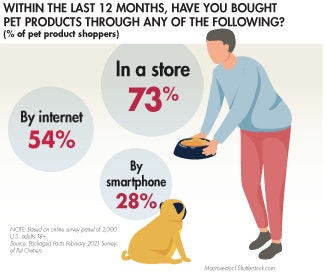
Editor’s note: This article is the first of a three-part series on the pet industry reset in the wake of the COVID-19 pandemic. Subsequent articles will focus on pet product spending and pet acquisition/adoption.
Because most of the pet industry impacts associated with COVID-19 are in fact accelerations of existing trends, only a limited “return to normal” can be expected. Instead, COVID-19 is best understood as having fast-forwarded the industry into the future.
The remix of physical and digital shopping
This reset of the U.S. pet industry, now even more sharply (and sometimes awkwardly) straddling the twin peaks of consumer convenience and pet wellbeing, is characterized by a permanent remix of physical and digital shopping behaviors. This remix includes a growing role for direct manufacturer-to-consumer selling and shipping, along with the polar consumer options of retailer-based autoship vs. same-day delivery.
Packaged Facts’ February 2021 online survey shows the impacts that COVID-19 — factoring in related economic and physical dislocations — has significantly changed the “where or how” of buying pet products for one-third of pet owners.
Among pet product shoppers, 39% report shopping in stores less for pet products because of COVID-19 impacts, compared to 9% who shopped in stores more. The general level of in-store shopping for pet products therefore remained about the same for half of pet product customers.
Conversely, 40% report shopping online more for pet products because of COVID-19 impacts, compared to 6% who shopped online less. As with in-store shopping, the general level of online shopping for pet products remained about the same for about half of pet product customers.
In the wake of COVID-19, nearly three-fourths of pet product customers buy at least some pet products in-store, half buy at least some pet products online and one-fourth use a smartphone (see Table 1).

TABLE 1: In the wake of COVID-19’s effects on shopping patterns, more than half of pet owners in the U.S. now buy at least some of their pet products online.
Brick-and-mortar, omnichannel still maintain an advantage
Even though COVID-19 impacts have remixed retail shopping in favor of digital options, brick-and-mortar-based or omnichannel (store + website) retailers retain an advantage in pet product customer loyalty over pure play internet retailers. That is, two-thirds of brick-and-mortar customers strongly or at least somewhat agree that they are loyal to the main store where they buy pet products, compared to half of website pet product shoppers.
With that said, it’s the 28% of pet product shoppers who buy through a smartphone — whether from omnichannel players such as Walmart, PetSmart or Petco, or from pure play internet retailers such as Amazon or Chewy — who show a somewhat sharper edge in retailer loyalty, a hard-won prize in the current omnimarket era. One-third of smartphone shoppers strongly agree that they are loyal to the main store or website where they buy pet products. In comparison, among customers who don’t buy pet products at least partly through smartphones, only one-fourth are loyal.
In the not-too-distant future, discussing “online” shopping without reference to apps may become as quaint as talking about cell phones without reference to their nimbler smartphone cousins.

















